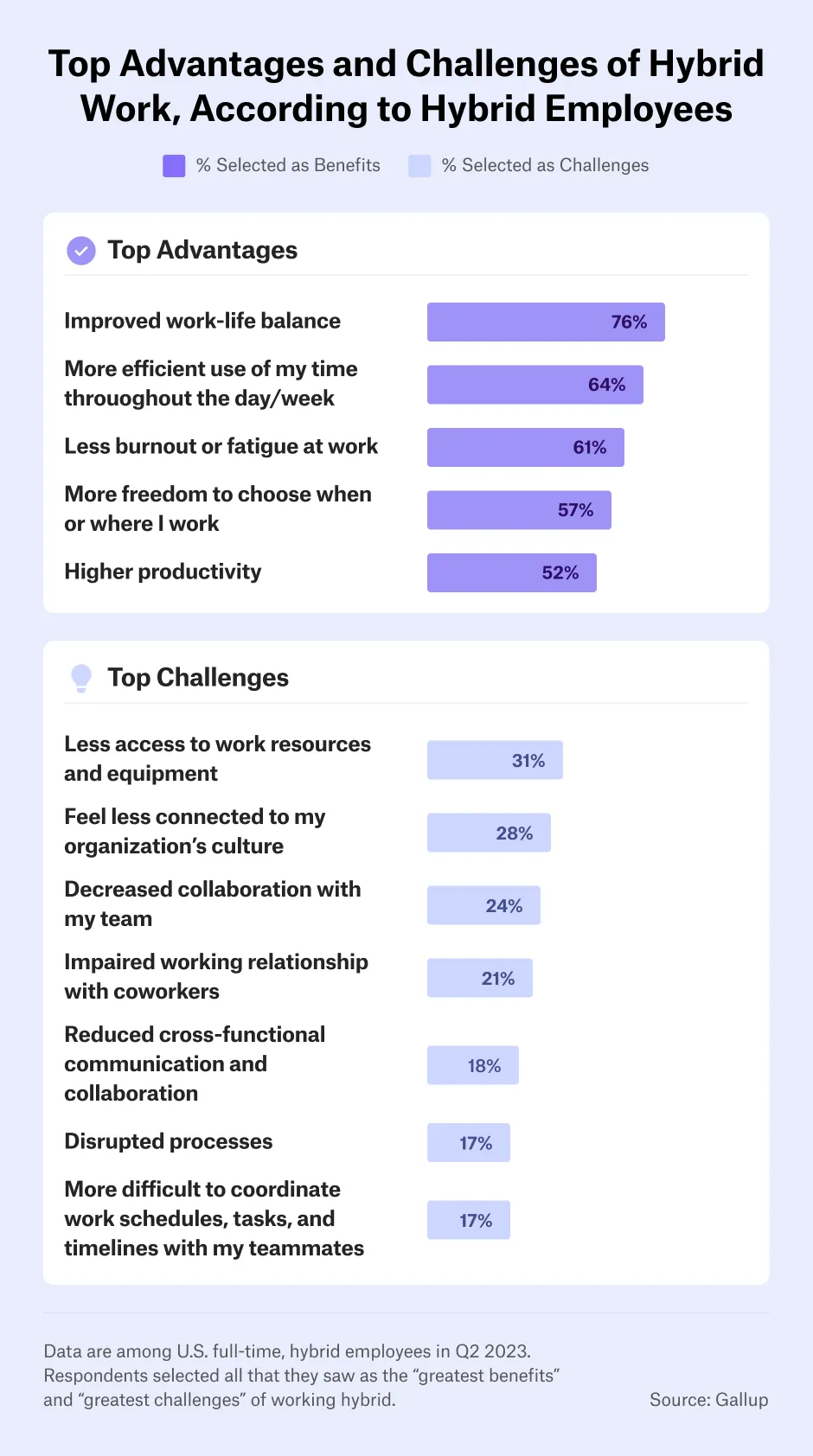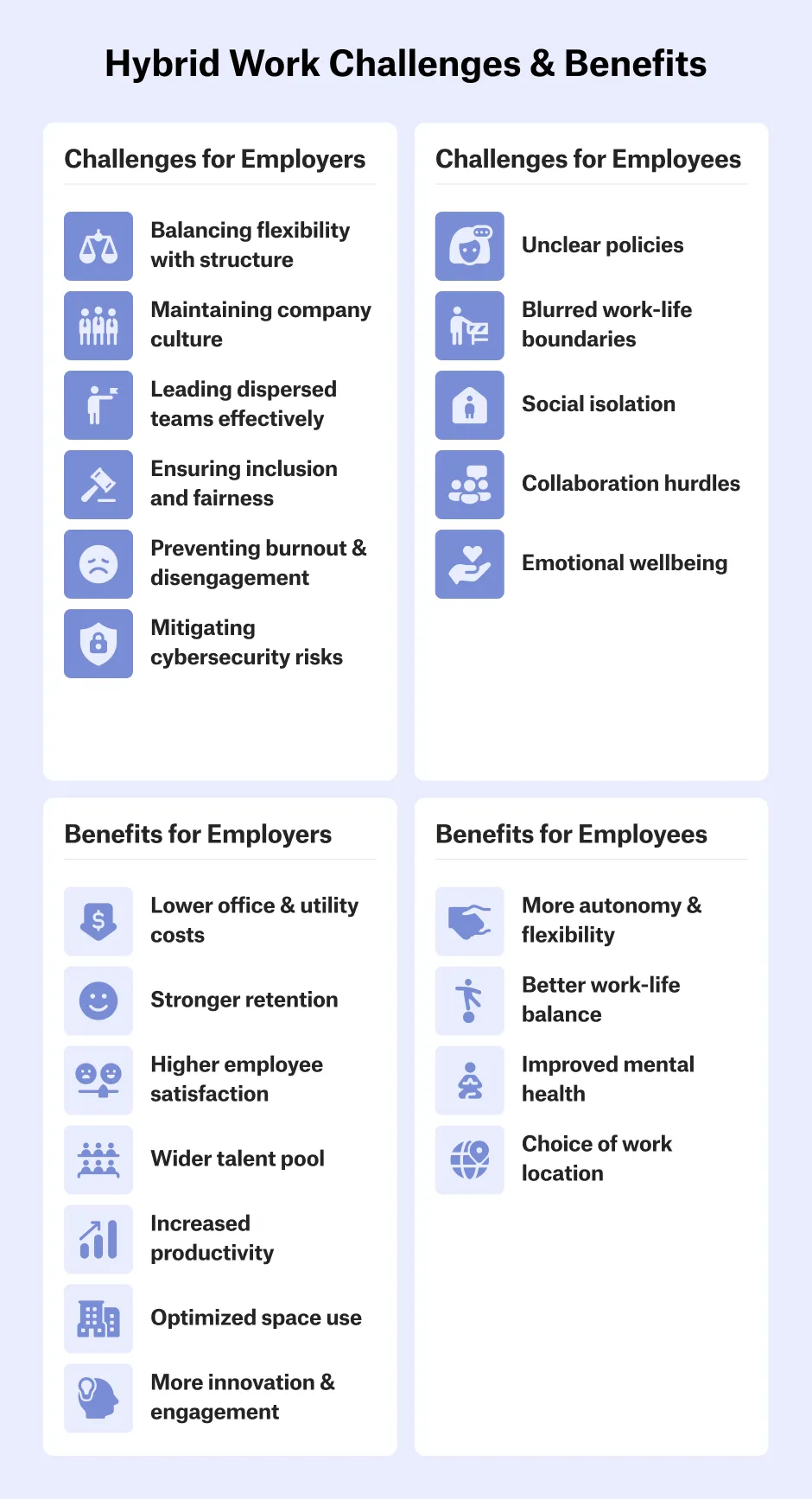Hybrid work 101: Benefits, challenges and tips
What hybrid work means, its top benefits and challenges, and how to set up flexible work in order to drive productivity.

Flexible work is how modern organizations attract top talent, boost productivity, and keep people engaged. By blending flexibility with in-person connection, hybrid work helps employees thrive while strengthening company culture. Yet without a structured approach, hybrid setups can easily slip into confusion, inequity, and disengagement. This opening chapter of our hybrid work guide explores both the benefits and challenges of flexible work and offers practical tips and solutions on how to overcome them.
Key takeaways:
- Hybrid work boosts work-life balance, productivity, and retention, thereby empowering employees while cutting costs and expanding talent reach.
- Without clear policies and cultural cohesion though, teams risk disconnection and inefficiency across distributed setups.
- Hybrid work success is achieved through intentional design, requiring strong leadership training, inclusive communication, adaptable policies, and a smart digital infrastructure.
What is hybrid work?
Hybrid work is a flexible working model that allows employees to split their time between the office and other locations, such as their home, a coworking space, or any other location where they feel productive. Depending on the company’s hybrid work policy, in-office days may be fixed (e.g., on team level) or chosen freely by each employee. In today’s day and age, hybrid work reflects an important shift towards employee autonomy, work-life balance, and inclusivity.
Hybrid work isn’t a ‘problem’ to solve but a transformative approach requiring active, data-driven management.
— Prof. Johanna Bath, Hybrid Work Expert, Author, Speaker & LinkedIn Top Voice
Remote vs. hybrid work: Which one has the upper hand?
Remote work gives people the freedom to work from anywhere, but hybrid takes it a step further. It combines that flexibility with the connection and energy of in-person collaboration. Here are three key reasons why hybrid is often a better option than going fully remote.
- Strengthens workplace connection: Hybrid work enables social interaction like team lunches and spontaneous collaboration which is something remote work often lacks.
- Preserves company culture: Regularly spending time at the office makes it easier to maintain shared values and a strong team identity.
- Meets diverse workforce needs: Hybrid work offers flexibility while accommodating different preferences across a multi-generational workforce which is becoming the norm in most workplaces today.
How to know if hybrid work is right for your organization
Hybrid work isn’t right for every company. To succeed, your organization needs the right culture, tools, and leadership. A hybrid readiness assessment helps you evaluate whether flexible work will thrive in your environment. Key questions to answer include:
- Culture: Do we value trust, autonomy, and outcomes over physical presence?
- Leadership: Are managers trained to support both remote and in-person teams?
- Tools: Can our current platforms enable seamless collaboration across locations?
- Role suitability: Are most roles adaptable to flexible work arrangements?
- Employee input: Have we gathered feedback on preferred work styles and needs?
- Digital infrastructure: Do we have secure, reliable systems and IT support in place?
- Office design: Is our workspace adaptable for hybrid use and dynamic scheduling?
- Performance tracking: Can we measure productivity without micromanagement?
- Adaptability: Are we ready to evolve our hybrid model based on feedback and results?

What are the benefits of hybrid work?
Hybrid work brings advantages for both employees and employers by combining flexibility with organizational efficiency. The top advantages cited by employees include better work-life balance (76%), more efficient use of time (64%), and less fatigue and burnout (61%). For employers, it’s a smart move that can cut costs, boost engagement, and make it easier to attract and keep top talent. Beyond these benefits, hybrid work also delivers measurable ROI—improving productivity, lowering turnover, reducing office expenses, and strengthening overall team morale.
Hybrid work benefits for employers
- Lower costs: Reduced need for large offices cuts rent and utilities.
- Stronger retention: Flexibility decreases burnout, absenteeism, and turnover.
- Higher satisfaction: Employee-centric policies build trust and loyalty.
- Expanded talent pool: Recruitment extends beyond geographic limits.
- Improved productivity: Choice of work environment drives better results.
- Efficient space use: Smart scheduling optimizes office capacity.
- Greater innovation: Blending remote and in-person collaboration sparks engagement.
Hybrid work benefits for employees
- Autonomy and flexibility: Freedom to work during peak productivity hours.
- Work-life balance: Less commuting and more time for personal needs.
- Mental health support: Reduced stress and fatigue from flexible arrangements.
- Choice of environment: Ability to work from home, coworking spaces, or preferred settings.
What are the biggest challenges of hybrid work?
Hybrid work creates flexibility and freedom, but it also brings new obstacles and challenges. According to Gallup, the top three challenges in hybrid work are limited access to necessary tools and resources (31%), a weakened sense of connection to company culture (28%), and reduced teamwork (24%).
Employee challenges with hybrid work
- Unclear policies: Confusion around schedules, availability, and communication norms.
- Work-life boundaries: Blurred lines between personal and professional time.
- Social isolation: Limited in-person interaction weakens relationships and morale.
- Collaboration hurdles: Gaps in tools and shared systems reduce efficiency.
- Emotional well-being: Lack of connection can leave employees feeling disconnected.
A big challenge for many companies is to combine the pre-pandemic world with the full-remote approach during the last months and take the best of both worlds.
– Mario Niederhauser, Consultant at beetroot
Employer challenges with hybrid work
- Balancing flexibility and structure: One-size-fits-all models don’t meet diverse needs.
- Culture erosion: Reduced office presence weakens shared identity and engagement.
- Leadership gaps: Managing hybrid teams requires new communication and trust skills.
- Inclusion and equity: Remote employees risk losing visibility and opportunities.
- Burnout risk: Poor planning increases stress and disengagement.
- Cybersecurity risks: Distributed work expands exposure to data breaches.

Tips for overcoming hybrid work challenges
Hybrid work challenges can be overcome with a proactive approach that balances employee needs, culture, and technology. The key is to treat hybrid work as a system to manage, not a problem to fix, by using data, clear policies, intentional design, and inclusive leadership. Putting a special focus on employee engagement ensures teams stay connected and feel properly supported.
- Get employee feedback: Engage your teams in shaping hybrid policies to ensure they reflect real needs and preferences.
- Leverage workplace analytics: Use data to optimize tools, space usage, and communication patterns.
- Create tailored guidelines: Regularly update hybrid work policies to align with evolving employee and business needs.
- Redesign your office space: Focus on creating more collaborative spaces and scale your office size appropriately.
- Optimize your digital infrastructure: Invest in smart tools (e.g., desk booking apps and communication tools) that support flexible work models.
- Promote intentional communication: Keep employees informed through regular check-ins, clear updates, and open feedback loops.
- Foster a hybrid-friendly culture: Ensure equal access to opportunities and recognition regardless of location.
- Build structured social interaction: Organize virtual coffee chats, offsites, and team-building activities to reduce isolation.
- Support employee wellbeing: Promote work-life balance through flexible schedules, workload management, and mental health resources.
How to implement a hybrid work strategy
Successful hybrid work requires clear strategy, structure, and continuous adaptation. Without thoughtful planning, even the best-intentioned hybrid models can lead to confusion, inequality, or disengagement. Use this roadmap to design and refine your hybrid approach.
1. Choose a hybrid work model
Decide what hybrid means for your organization. Will it be office-first, remote-first, fixed schedule, or at-will? Or something else entirely? Tailor your hybrid work model to suit your business goals, roles, and workforce preferences.
2. Define a hybrid work schedule
Establish expectations around in-office days, remote flexibility, and availability. Ensure consistency across teams while allowing room for individual and departmental needs. A clearly defined hybrid work schedule is a key ingredient to successful flexible work.
3. Design your hybrid work policy
Outline a clear hybrid work policy detailing eligibility, expectations, performance measures, and communication guidelines. Then share these guidelines with your employees to make sure everyone is on the same page and understands expectations, tools, and support channels.
4. Enable efficient hybrid leadership
Provide training on hybrid management, asynchronous communication, and digital collaboration. Empower managers and team leaders to set clear expectations, build trust, and measure success based on actual outcomes. Leadership in a hybrid work environment works differently than in-office so you need to prepare accordingly.
5. Invest in the right tools
Equip your teams with a reliable digital infrastructure, including communication platforms, project management tools, and secure access to files and systems, and choose the right hybrid work solution for your business. The use of technology and hybrid work tools (or lack thereof) can make or break hybrid work success.
6. Optimize your physical workspace
Rethink your physical office space and redesign it to support hybrid use. Incorporate hot desks, collaborative zones, and well-equipped meeting rooms to support seamless in-person and remote interaction.
7. Monitor, measure, and adapt
Use feedback, performance metrics, and workplace analytics to assess how your hybrid setup is working. This allows you to continuously refine policies, schedules, and tools to keep pace with evolving workforce and business needs, and make improvements wherever needed.
Conclusion: Is hybrid work worth it?
Hybrid work is a solid long-term strategy for building a more flexible, resilient, and people-centric workplace. Done right, it can boost productivity, cut costs, and keep your team engaged. But success doesn’t come from guesswork.
Successful flexible working requires structure, clarity, and the right mindset. In the next chapter, we’ll dive into one of the most important steps: defining your hybrid work model. Read on to discover different hybrid work model types, their benefits and challenges, and learn how to pick the best model for your organization.
Hybrid Work FAQs
Do employees prefer hybrid work?
Yes, an overwhelming majority of employees prefer working in a hybrid setup. In fact, 60% of remote‑capable employees prefer a hybrid work arrangement, while only about one-third want fully remote and less than 10% prefer full on-site work (Source: Gallup).
What is the difference between flexible working and hybrid working?
Flexible working refers to any arrangement that gives employees control over how, when, or where they work, such as flexible hours or compressed weeks. Hybrid working is a specific type of flexible work where time is split between remote and in-office locations.
How many people work hybrid or remote?
How to engage hybrid employees?
Keep communication clear with regular check-ins, updates, and open feedback. Build a hybrid-friendly culture where everyone has equal opportunities and feels part of the bigger mission. Create social touchpoints like virtual coffee chats and offsites. Support wellbeing with flexibility and mental health resources. Celebrate wins often and give people room to grow, while trusting them to deliver.
What trends are shaping the future of hybrid work, and how will they impact office spaces and company culture?
With hybrid work, offices are becoming more like collaboration hubs than daily desks, as flexibility, better digital tools, and cost savings drive change. This shift is pushing companies to build culture through purposeful meet-ups, employee wellbeing efforts, and personalized work styles that keep people happy, connected, and productive.

Easily manage hybrid work with deskbird
- Coordinate hybrid policies, in-office days, and team presence
- Use real-time data to optimize office usage and avoid empty desks
- Give teams clarity on who’s in and who's working remote
Trusted by 100,000+ employees worldwide









